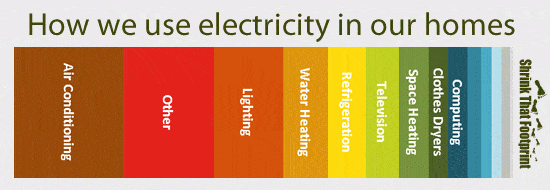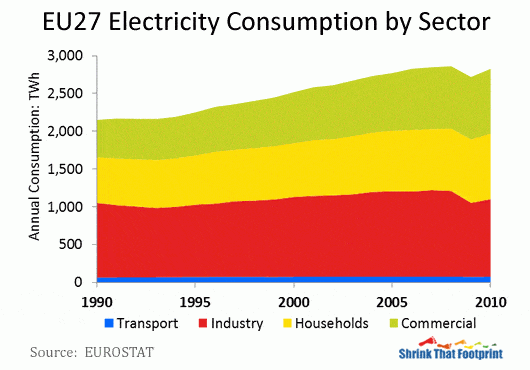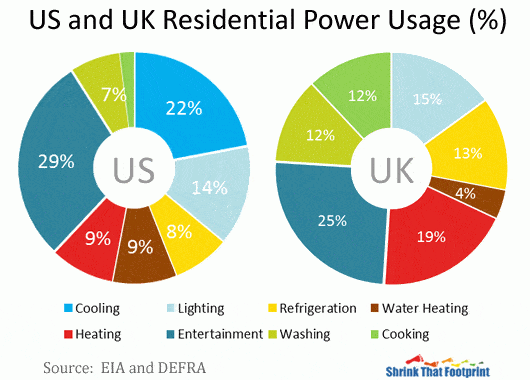Introduction – What Are The Major Uses of Electricity
What uses the most electricity in a home? How many kWh does a house use? We use electricity virtually every minute of every day. Yet few of us understand the major uses of electricity in our homes. By answering the simple question ‘how do we use electricity’ this post helps us understand our own electricity use.

History Of Electricity Use
Electricity has been around since ancient times, but it wasn’t until the late 18th century that scientists began to understand its potential and develop ways to use it. In 1791, Luigi Galvani conducted experiments with frogs’ legs and electricity, which paved the way for the modern science of electricity. In 1800, Alessandro Volta invented the first battery, which provided a more reliable and consistent source of electricity than had previously been available.
In the 19th century, inventors and entrepreneurs began to use electricity to power their inventions, such as the telegraph, telephone, and electric light bulb. By the early 20th century, electricity had become widely available, and it quickly became an essential part of modern life. Today, electricity is used to power a variety of devices and appliances, from computers and cell phones to air conditioners and refrigerators. The different uses really took off at the beginning of the 20th century. So our uses today are the result of 100 years of invention and consumerism.
What Is Electricity Used For? One Third Is For Home
Before we dive into how electricity is used around the home it is worth putting household electricity use in perspective. Household electricity use generally makes up about a third of total electricity consumption in most developed nations. Using data from the European Union we can give an example of how electricity demand is split among different sectors.

Among the twenty-seven countries that make up the European Union electricity is used primarily by industry (36%), households (31%) and the commercial sector (30%), while transport (3%) is a small share. For this purpose the ‘commercial’ sector includes both private and public services while industry is mostly manufacturing. It would be quite interesting to see a breakdown of each, for example what industries use the most electricity.
Although this breakdown varies from country to country the three-way slit between industry, households and the commercial sector is a good rough guide for any developed country. Total generation is typically 5-10% more than this total due to transmission and distribution losses.
So when we talk about household electricity use, it is worth remembering homes only account for a about a third of total electricity use.
How Does Electricity Get Into Our Homes?
Electricity is typically delivered to homes via power lines. Power lines are made up of two or three wires that are connected to an electricity substation. The electricity is then distributed through transformers, which step down the voltage and increase the current. The electricity is then sent to homes via a series of underground cables. The electricity is then routed into the home through an electrical meter, which measures the amount of electricity used. Finally, the electricity is sent to outlets and other devices inside the home.
What Uses The Most Electricity In The Home?
Average household electricity use varies greatly between countries. The average American home uses two and a half times that of a UK household. Compared to an Italian home, it uses more than four times. And compared to an Indian home it is a mind boggling ten times more. Even though there are huge differences in household electricity use, we all tend to use electricity for similar kinds of activity. Below we pulled out and analyzed the data collected by the EIA survey of households to show what uses the most electricity in a home.
| What uses electricity most | Average kWh / person | Percentage |
| All cooling (AC, air handler, fans) | 716 | 22.72% |
| All heating (except water) | 594 | 18.85% |
| Water heating | 494 | 15.69% |
| Lighting | 373 | 11.85% |
| All refrigerators (first, second) | 253 | 8.05% |
| Entertainment (TV, streaming) | 249 | 7.92% |
| Clothes (washing, drying) | 180 | 5.72% |
| Cooking (stove, microwave) | 91 | 2.89% |
| Humidifier, dehumidifier | 66 | 2.09% |
| Separate freezers | 59 | 1.86% |
| Pool and hot tub | 54 | 1.71% |
| Dish-washers | 21 | 0.65% |
In a separate article we cover what uses the most electricity in a home and in addition we separately cover what uses the most electricity in an apartment. The total electricity use per person is about 3150 kWh per year. This number is pretty close to 1/3 of the 11,000 kWh used by a household over a year.
Notably, the biggest use is cooling which includes air conditioning, ceiling fans, air handlers. The second biggest use is heating, which we separated out from water heat. We also talk about most energy efficient refrigerators here, and the most energy efficient freezers in a separate article. Among these, dishwashers are at the very bottom as dishwashers cost about $25-$50 per year to run.
The Breakdown Of Electricity Use Is Similar Across The World
American households use two and a half times the electricity of UK homes. Despite that, they each use electricity for similar activities, with the notable exception air conditioning.
In the UK the major uses of electricity are entertainment (25%), heating (19%), lighting (15%), refrigeration (13%), cooking (12%) and washing (12%), which includes clothes drying.
For the US they are air conditioning (22%), heating (19%), water heating (16%), lighting (12%), entertainment (8%), and refrigeration (8%).
Because both of these figures are based on national averages they can be a little deceptive. If for example a home uses electricity as its primary source of energy for cooking, water heating or heating these uses will likely be more dominant.
Beyond simple percentages it also helps to see where the watts are going.
What Uses The Most Electricity In A Home?
The average American home uses 10,557 kWh each year – this number has remained steady or dropped due to improvements in energy efficiency. The cost is around $1,400 and it causes about 7 t CO2e in carbon emissions.
Reducing electricity usage is a big opportunity to cut both power bills and carbon emissions. And the first step towards cutting electricity usage is understanding it.

This graph shows how much electricity the average American household used for different tasks in 2010.
By separating electricity use into different end uses we can see where the major demand for electricity is in US homes.
Air Conditioning, Lighting, Water Heating And Refrigeration Are The Biggest Users Of Electricity
Air conditioning is a big user, so are lighting, water heating and refrigeration. The ‘other’ group which includes gadgets and appliances is also a big draw, and has been growing sharply in recent years.
Understanding how electricity is used can help prioritize opportunities to reduce it. For example this chart shows that defrosting a freezer has limited potential. Switching to low energy light bulbs or limiting air-con use will have greater potential to reduce electricity use.
Cooking Is A Much Smaller Percentage
From the statistics, we see that using electricity to cook is at most 12% in the UK and less in the US. Even so, there is opportunity to reduce electricity use, for example by switching from less efficient electric coil stove tops to inductive cookers that are more efficient.
Whether your home uses 2,000 or 10,000 kWh a year there will be simple ways you can save electricity in your home. Understanding how we use electricity is a good starting point for taking control of our own use of electricity.
The logical next step to this post is to ask “how do I use electricity?” We’ll tackle this next week by describing how to conduct your own electricity audit.
Lindsay Wilson
I founded Shrink That Footprint in November 2012, after a long period of research. For many years I have calculated, studied and worked with carbon footprints, and Shrink That Footprint is that interest come to life.
I have an Economics degree from UCL, have previously worked as an energy efficiency analyst at BNEF and continue to work as a strategy consultant at Maneas. I have consulted to numerous clients in energy and finance, as well as the World Economic Forum.
When I’m not crunching carbon footprints you’ll often find me helping my two year old son tend to the tomatoes, salad and peppers growing in our upcycled greenhouse.
